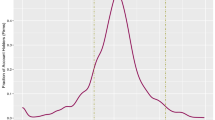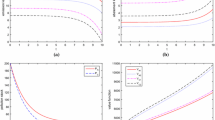Abstract
This paper proposes a computable stochastic equilibrium model to represent the possible competition between Russia and China on the international market of carbon emissions permits. The model includes a representation of the uncertainty concerning the date of entry of developing countries (e.g., China) on this market in the form of an event tree. Assuming that this date of entry is an uncontrolled event, we model the competition as a dynamic game played on an event tree and we look for a solution called S-adapted equilibrium. We compare the solution obtained from realistic data describing the demand curves for permits and the marginal abatement cost curves in different countries, under different market and information structures: (i) Russia's monopoly, (ii) Russia–China competition in a deterministic framework, (iii) Russia–China competition in a stochastic framework. The results show the possible impact of this competition on the pricing of emissions permits and on the effectiveness of Kyoto and post-Kyoto agreements, without a US participation.
Similar content being viewed by others
References
J.E. Aldy, P.R. Orszag and J.E. Stiglitz, Climate change: An agenda for global collective action, Prepared for the conference on the Timing of Climate Change Policies, Pew Center on Global Climate Change (October 2001).
M. Babiker, H. Jacoby, J. Reilly and D. Reiner, The evolution of a climate regime: Kyoto to Marrakech, Report no 82, MIT Joint Program on the Science and Policy of Global Change, Cambridge, MA (February 2002).
S. Barrett, Self-enforcing international environmental agreements, Oxford Economic Papers 46 (1994) 878–894.
T. Ba¸sar and G.J. Olsder, Dynamic Noncooperative Game Theory (Academic Press, London, 1989).
H. Benchekroun and N.V. Long, Leader and follower: A differential game model, working paper, CIRANO, Montreal (February 2001).
A. Bernard and M. Vielle, Toward a future for the Kyoto Protocol: Some simulations with GEMINI-E3, unpublished paper (2001).
A. Bernard and M. Vielle, Does non-ratification of the Kyoto Protocol by the US increase the likelihood of monopolistic behavior by Russia in the market of tradable permits?, paper presented at the 5th Annual Conference on Global Economic Analysis, GTAP, Taipei (2002).
A. Bernard, J. Reilly, M. Vielle and L. Viguier, Russia's role in the Kyoto Protocol, paper presented at the Annual Meeting of the International Energy Workshop jointly organized by EMF/IEA/IIASA, Stanford University, USA (18-20 June 2002).
A. Bernard, A. Haurie, M. Vielle and L. Viguier, A two-level dynamic game of carbon emissions trading between Russia, China, and Annex B countries, NCCR-WP4 Working paper #11, Geneva (September 2002).
O. Blanchard, Scenarios for differentiating commitments: A quantitative analysis, in: Building on the Kyoto Protocol: Options for Protecting the Climate, ed. K.A. Baumert (World Resources Institute, October 2002).
O. Blanchard, P. Criqui and A. Kitous, Après La Haye, Bonn et Marrakech: le futur marché international des permis de droits d'émissions et la question de l'air chaud, IEPE, Working Paper (Janvier 2002).
C. Carraro and D. Siniscalco, Strategies for the international protection of the environment, Journal of Public Economics 52 (1993) 309–328.
P. Criqui, POLES 2.2., JOULE II Programme, European Commission DG XVII-Science Research Development, Bruxelles, Belgium (1996).
P. Criqui, S. Mima and L. Viguier, Marginal abatement costs of CO2 emission reductions, geographical flexibility and concrete ceilings: an assessment using the POLES model, Energy Policy 27 (1999) 585–601.
P. Criqui and L. Viguier, Kyoto and technology at world level: Costs of CO2 reduction under flexibility mechanisms and technical progress, International Journal of Global Energy Issues 14 (2000) 155–168.
E.J. Dockner, S. Jorgensen, N.V. Long and G. Sorger, Differential Games in Economics and Management Sciences (Cambridge University Press, Cambridge, UK).
D.J. Dudek and J.B. Wiener, Joint implementation, transaction costs, and climate change, OCDE, OCDE/GD(96)173, Paris (1996).
J. Eyckmans and H. Tulkens, Simulating coalitionally stable burden sharing agreements for the climate change problem, CORE Discussion Paper 9926, Louvain, Belgium (July 2002).
A.D. Ellerman and A. Decaux, Analysis of post-Kyoto CO2 emissions trading using marginal abatement curves, MIT Joint Program on the Science and Policy of Global Change, Report no 40, Cambridge, MA (1998).
M.C. Ferris and J.S. Pang, Complementarity and Variational Problems: State of the Art (SIAM Publications, Philadelphia, Pennsylvania, 1997).
M.C. Ferris and T.S. Munson, Complementarity problems in GAMS and the PATH solver, Journal of Economic Dynamics and Control 24 (2000) 165–188.
M. Germain and J.-P. Van Ypersele, Financial transfers to sustain international cooperation in the climate change framework, CORE Discussion Paper n 9936, Louvain, Belgium (1999).
R.W. Hahn and G.L. Hester, Marketable permits: Lessons for theory and practice, Ecology Law Quarterly 16 (1989) 361–406.
R. Hamalainen, A. Haurie and V. Kaitala, Equilibria and threats in a fishery management game, Optimal Control Applications and Methods 6(4) (1986) 315–333.
A. Haurie and F. Moresino, Computation of S-adapted equilibria in piecewise deterministic games, in: Advances in Dynamic Games, Annals of International Society of Dynamic Games, eds. E. Altman and O. Pourtallier, Vol. 6 (2001) pp. 225–252.
A. Haurie and F. Moresino, S-adapted oligopoly equilibria and approximations in stochastic variational inequalities, Annals of Operations Research, to appear.
A. Haurie, Y. Smeers and G. Zaccour, Stochastic equilibrium programming for dynamic oligopolistic markets, Journal of Optimization Theory and Applications 66 (1990) 2.
A. Haurie and G. Zaccour, S-adapted equilibria in games played over event trees: An overview, to appear in Annals of International Society of Dynamic Games, Vol. 7.
P.L. Joskow, R. Schmalensee and E.M. Bailey, The market for sulfur dioxide emissions, The American Economic Review 88(4) (1998) 669–685.
F. Jotzo and A. Michaelowa, Estimating the CDM market under the Marrakech Accords, Energy Policy, article in press.
V. Kaitala, Game theory models of fisheries management-a survey, in: Dynamic Games and Applications in Economics, ed. T. Basar (Springer, New York, 1986) pp. 252–66.
Leimbach and F. Toth, Economic development and emission control over the long term: The ECLIPS aggregated economic model, Climatic Change 56(1) (2003) 139–165.
K.-G. Mäler and A.J. de Zeeuw, The acid rain differential game, Environmental and Resource Economics 12 (1998) 167–184.
A. Michaelowa and M. Stronzik, Transaction costs of the Kyoto mechanisms, HWWA Discussion Paper 175, Hamburg (2002).
A.P.G. de Moor, M.M. Berk, M.G.J. den Elzen and D.P. van Vuuren, Evaluating the Bush climate change initiative, RIVM Report 728001019/2002 (2002).
B. Mueller, Varieties of distributive justice in climate change, Climatic Change 48(2-3) (2001).
A. Nagurney and K.D. Kanwalroop, Marketable pollution permits in oligopolistic markets with transaction costs, Operations Research 48(3) (2000) 424–435.
S.V. Paltsev, The Kyoto Protocol: "Hot air" for Russia?, Working Paper No. 00-9, Department of Economics, University of Colorado (October 2000).
J.B. Rosen, Existence and uniqueness of equilibrium points for concave N-person games, Econometrica 33 (1965) 520–534.
R.N. Stavins, Transaction costs and tradeable permits, Journal of Environmental Economics and Management 29 (1995) 133–148.
D. van Vuuren, L. Yun, B. de Vries, J. Kejun, C. Graveland and Z. Fengxi, Energy and emission scenarios for China in the 21st century exploration of baseline development and mitigation options, Energy Policy, in press.
A.J. de Zeeuw and F. van der Ploeg, Differential games and policy evaluation: A conceptual framework, Oxford Economic Papers 43 (1991) 612–636.
Z.X. Zhang, Estimating the size of the potential market for the Kyoto flexibility mechanisms, Weltwirtschaftliches Archiv-Review of World Economics 136 (3) 491–521.
G. Zaccour, Théorie des jeux et marchés énergétiques: marché européen de gaz naturel et échanges d'électricité, PhD thesis, HEC, Montréal (1987).
Author information
Authors and Affiliations
Rights and permissions
About this article
Cite this article
Haurie, A., Viguier, L. A Stochastic Dynamic Game of Carbon Emissions Trading. Environmental Modeling & Assessment 8, 239–248 (2003). https://doi.org/10.1023/A:1025599324868
Issue Date:
DOI: https://doi.org/10.1023/A:1025599324868




